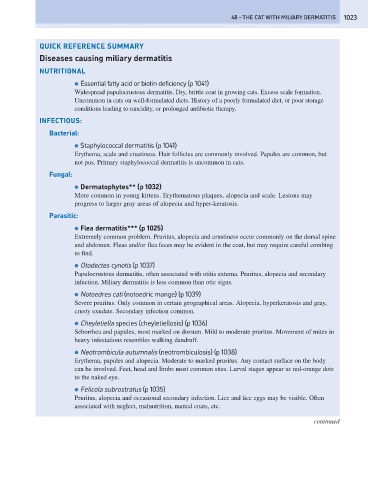Page 1031 - Problem-Based Feline Medicine
P. 1031
48 – THE CAT WITH MILIARY DERMATITIS 1023
QUICK REFERENCE SUMMARY
Diseases causing miliary dermatitis
NUTRITIONAL
● Essential fatty acid or biotin deficiency (p 1041)
Widespread papulocrustous dermatitis. Dry, brittle coat in growing cats. Excess scale formation.
Uncommon in cats on well-formulated diets. History of a poorly formulated diet, or poor storage
conditions leading to rancidity, or prolonged antibiotic therapy.
INFECTIOUS:
Bacterial:
● Staphylococcal dermatitis (p 1041)
Erythema, scale and crustiness. Hair follicles are commonly involved. Papules are common, but
not pus. Primary staphylococcal dermatitis is uncommon in cats.
Fungal:
● Dermatophytes** (p 1032)
More common in young kittens. Erythematous plaques, alopecia and scale. Lesions may
progress to larger gray areas of alopecia and hyper-keratosis.
Parasitic:
● Flea dermatitis*** (p 1025)
Extremely common problem. Pruritus, alopecia and crustiness occur commonly on the dorsal spine
and abdomen. Fleas and/or flea feces may be evident in the coat, but may require careful combing
to find.
● Otodectes cynotis (p 1037)
Papulocrustous dermatitis, often associated with otitis externa. Pruritus, alopecia and secondary
infection. Miliary dermatitis is less common than otic signs.
● Notoedres cati (notoedric mange) (p 1039)
Severe pruritus. Only common in certain geographical areas. Alopecia, hyperkeratosis and gray,
crusty exudate. Secondary infection common.
● Cheyletiella species (cheyletiellosis) (p 1036)
Seborrhea and papules, most marked on dorsum. Mild to moderate pruritus. Movement of mites in
heavy infestations resembles walking dandruff.
● Neotrombicula autumnalis (neotrombiculosis) (p 1038)
Erythema, papules and alopecia. Moderate to marked pruritus. Any contact surface on the body
can be involved. Feet, head and limbs most common sites. Larval stages appear as red-orange dots
to the naked eye.
● Felicola subrostratus (p 1035)
Pruritus, alopecia and occasional secondary infection. Lice and lice eggs may be visible. Often
associated with neglect, malnutrition, matted coats, etc.
continued

